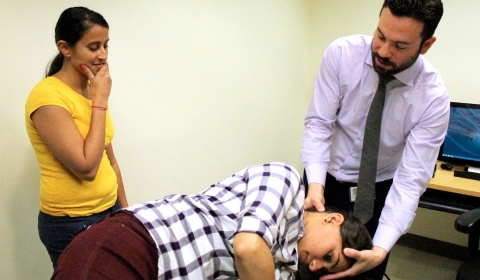
One of the most common forms of vertigo, Benign Paroxysmal Positional Veritgo (BPPV) occurs when loose “crystals” from the one parts of the inner ear (the utricle) break off and end up in another part of the inner ear (typically the posterior semicircular canal). The “crystals”, aka otoconia, are composed of calcium carbonate, and help the utricle sense head tilt and acceleration by acting as a weight that will slide relative to the hair cells with head position changes. They can be displaced from the utricle for a variety of reasons, including aging, trauma, inflammation (neurititis), Menière’s disease, and surgery. Since the semicircular canals are designed to sense fluid movement (via the crista ampullaris) as part of their job in sensing head rotations, when the loose otoconia end up in the semicircular canals, they can mimic fluid movement, sending a false signal to the brain that you are moving quickly, when in reality you are not. This produces dizziness, nystagmus (rhythmic eye movement in same plane as the canal being stimulated), and nausea. Most cases involve the posterior semicircular canal, due to the fact that it is the most dependent portion of the inner ear (similar to why debris collects in the U-bend under a sink). However, the other two semicircular canals (the horizontal canal and the superior canal) can be affected as well, although this is much rarer. Treatment is aimed at moving the otoconia back into the vestibule, where it won’t cause problems (and is likely reabsorbed but no one really knows). This is usually accomplished with the Epley maneuver for posterior canal BPPV, although occasionally other maneuvers (Semont, Brant-Daroff, Log Roll, Gufoni, etc.) are needed. Surgery can be considered in very rare cases where particle repositioning maneuvers are not effective, but this is very uncommon.
Posterior Canal BPPV
This video provides an overview of Benign Paroxysmal Positional Vertigo (BPPV). If this is your first time to the website, you must watch this video first, before watching any of the other videos. This is because this video contains important background information about BPPV, including important warnings about when it is safe to do any of the treatment maneuvers described in the other videos at home, and when it is not safe or advised to do so.
Introduction to BPPV
Epley Left
Epley Right
Other Videos
Semont Left
Brandt Video
Semont Right
Horizontal Canal BPPV
This video contains an overview of horizontal canal BPPV. It’s important to know that horizontal canal BPPV is rare, and therefore if you have been told that you have BPPV, without any other information, you have posterior canal BPPV, and the information about that is contained above. If you have been specifically told by a qualified medical provider that you have horizontal canal BPPV, or if you are just interested, then this section is for you. Please watch the “Introduction to BPPV” video first, and next please watch the “Introduction to Horizontal Canal BPPV” video. These videos must be watched prior to watching the videos on treatment maneuvers, because they contain important information that you need to know prior to doing any of the maneuvers.
Introduction to Horizontal Canal BPPV
Log Roll Left
Log Roll Right
Disclaimer: Please note that all the information contained on this Balance and Falls pages, including the treatment maneuvers for BPPV, are intended only to supplement medical care from a qualified medical professional. BPPV is a medical condition, and it should be diagnosed by a medical provider, and not “self diagnosed”. In addition, some patients with neck, back, or blood vessel disease can have problems if they try to do these maneuvers at home. Therefore, our goal is simply to provide an online resource, so that if you are instructed to do any of these maneuvers at home by a qualified medical professional, you have reference material available to help you do so.
